
I’m not a natural-born furniture enthusiast, but still found many items in the Möbelmuseum Wien (Vienna Furniture Museum) that caused my eyebrows to lift in admiration.
Here are my favorites.
- Thrones, cabinets and more from throughout the centuries
- Home to much Habsburg memorabilia, especially for Empress Elisabeth
- Also features plenty of creativity from the Biedermeier and Wiener Moderne eras
- Book a themed guided tour* of the city
- See also:
History in furniture form
Some items impress not so much for their physical characteristics but more for their place in history. For example…
A desk & Austrian independence
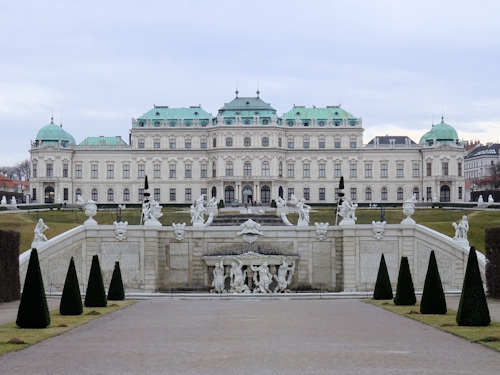
(A table in Baroque Belvedere palace witnessed a momentous moment)
One of the most important events in recent Austrian history was the 1955 signing of the State Treaty at Upper Belvedere. This saw the country regain its sovereign independence from the occupying WWII allies.
The museum has one of the tables used by the likes of Vyacheslav Molotov, John Foster Dulles, and Harold Macmillan to sign the document, together with behind-the-scenes photos and details of this pivotal occasion.
Elisabeth: a fate in objects
The famous 19th-century Empress known as Sisi obsessed over her looks and weight; the worn-down footplate on her weighing scales in the Möbelmuseum feels like a tragic reminder of the eternal battle against fat and social or self-imposed pressures.
Elsewhere, you also see one of the fans that Sisi hid behind to avoid the glare of public curiosity. Impressive how much you can learn about a person from a few simple household objects.
A fate in photographs
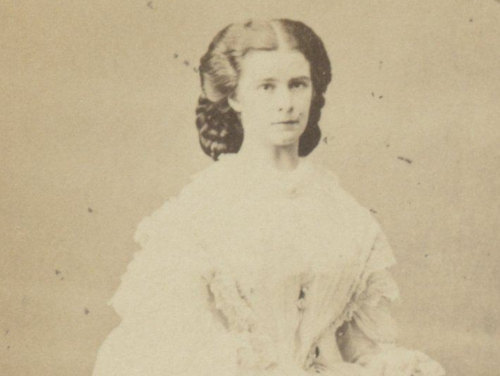
(Photograph of Empress Elisabeth by Ludwig Angerer, 1855 – 1870. Image courtesy of the Rijksmuseum)
An extensive set of lithographs and portraits also track Sisi through her life. If you know her biography from the Sisi Museum, you can almost see her inner struggles and personality in the frozen countenances.
Of the many photos, only one shows the empress with even a trace of a smile. Most exude melancholy and distance.
Crown Prince Rudolf’s high chair
A special mention goes to the ebony and velvet high chair used by Sisi’s son from around 1860. I always find it astonishing how even the most banal and practical of items still had to have that element of prestige about them.
Equally astonishing is the fact there appear to be no scratches and stains. I have three possible theories:
- Rudolf was a remarkably well-behaved toddler (unlikely)
- The museum restorers know their job (likely)
- The imperial family even had show versions of their children’s furniture to impress the neighbours (entirely possible)
Imperial cabinets
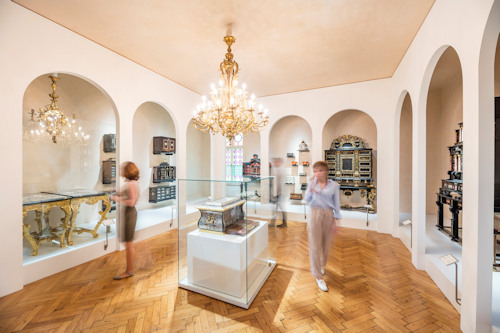
(Laxenburg room of the Vienna Furniture Museum; press photo © Schloß Schönbrunn Kultur- und Betriebsges.m.b.H / Severin Wurnig)
The cabinets in the Möbelmuseum’s Laxenburg room feature exquisite craftmanship and detail. They originally stood in the Franzensburg (a sort of castle reconstruction just outside Vienna and star of Season 2 of Vienna Blood).
We’re talking, for example, late 17th century designs made of ebony and pearwood with patterned inlays. I’m guessing they did not use these cabinets to store nails and leftover bits of string.
Imperial thrones
Emperor Franz II/I’s throne lacks the kind of ornate splendour you might imagine, despite the sphinxes and lion paw feet. Same goes for Emperor Franz Joseph’s throne, which is just a few steps away.
But to imagine such personalities sitting on exactly that item of furniture…wow!
You can even see Franz’s throne (and its Imperial occupant) in an adjoining 1815 painting by Johann Peter Krafft.
That direct contact with the past really does permeate the building. We also see, for example, the coffin used to transport Emperor Maximilian back to Austria after his 1867 execution in Mexico.
Biedermeier & bentwood beauties
The Möbelmuseum might be the best place in all of Vienna to view Biedermeier design.
The chairs and sofas lining one wall offer the rather delightful prospect of having your bottom pressing against genuine history (it’s OK: sitting is encouraged). They also make a comfortable spot to take a break from the rigours of meandering round a museum.
One chair you can’t sit on from a little later in history is the unassuming Thonet No.14, which sold in its millions from around 1859 onwards.
The example in the Möbelmuseum might just be the oldest on display anywhere in the world, predating even the steam-bending bentwood manufacturing process that made Thonet (and later iterations of the chair) so famous.
Moderne & modern
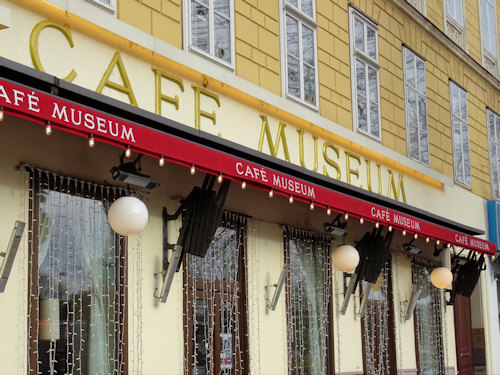
(Café Museum still operates today)
The items from the turn-of-the-century connect with famous designers recognisable from exhibitions in such locations as Vienna’s Leopold Museum or MAK.
So we have Otto Wagner-designed chairs from his own residences (which he also designed himself) on Rennweg and Döblergasse as well as his first villa.
One of Vienna’s more traditional coffee houses is Café Museum, so seeing some of their original furniture proved a delight: a Loos-designed chair from 1899 (when the café opened) and a Zotti-designed corner suite from 1930 (the first major refurbishment).
An existential reminder
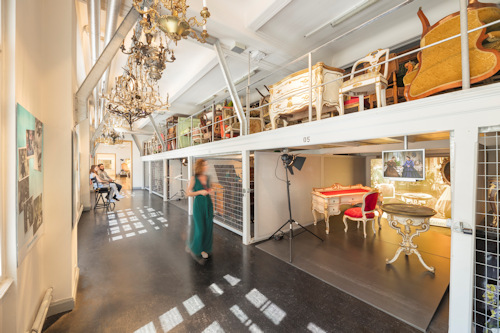
(Part of the walkthrough depot; press photo © Schloß Schönbrunn Kultur- und Betriebsges.m.b.H / Severin Wurnig)
Finally, the side of the building opposite the pristine displays of various rooms furnished in the Biedermeier fashion features a depot of objects held in the collection: original imperial items stacked carefully as if anticipating the removal van.
All that power and splendour reduced to a footnote in a museum storage facility.
On a dark and cold night, I might say the scene reflects the futility of human existence. But let’s just say it reminds us that individual rank and wealth are mere ephemera in the timeline of civilisation.
Ah, history…